Research
Research
How to meet conflicting needs in future materials development

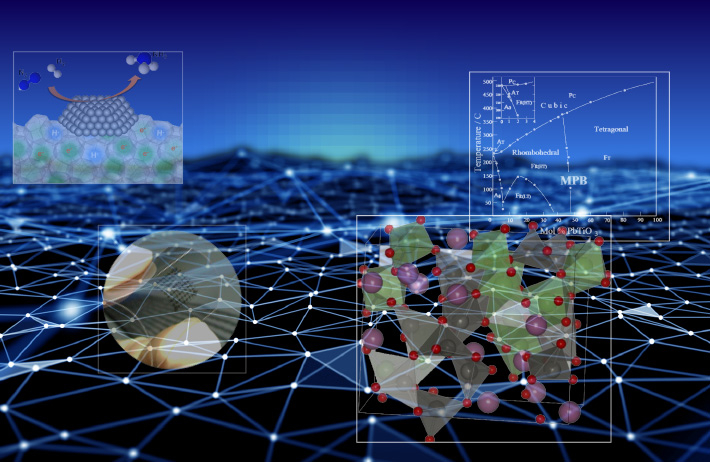
Professor Toshio Kamiya of the MDX Research Center for Element Strategy says that "Discovering an unknown material is like cultivating a new world. Improving existing materials alone is not enough to address conflicting needs, such as incremental improvement of performance and stability. The key to innovation is to develop materials that are distinct from existing materials in structure and properties, in other words, materials that are not just a logical extension of the past roadmap."
Our world has created smartphones, electric vehicles, and other innovative products in various fields, with increasing functionality. This phenomenon has been further accelerated by high-functional materials used in product parts such as semiconductors and batteries. The demand for higher functionality, especially Society 5.0 and carbon neutrality, is insatiable.
Tokyo Tech has been a global leader in materials research and development, making large contributions to the progress of society. Taking advantage of that experience, Tokyo Tech established the MDX Institute for Innovative Materials (MDX Institute) in October 2022 as a research and development institute for innovative materials. In 2019, the Academy for Convergence of Materials and Informatics was opened to train doctoral students, materials research "explorers" who will develop new materials and create new industries.
We asked Professor Toshio Kamiya, the director of the MDX Institute, about the aims and strategies of the new institute. We also asked Professor Takeo Yamaguchi, director of the Academy for Convergence of Materials and Informatics, about approaches and measures for training research talent.
—First of all, please tell us the background of what lead to launching the MDX Institute.

Director Toshio Kamiya
Kamiya In recent years, there has been a strong demand for developing new materials that contribute to the SDGs, especially new materials that achieve carbon neutrality, and to implement them in a short period of time.
For example, power semiconductors and high-k dielectrics for electric vehicles, hydrogen carriers and piezoelectric / thermoelectric bodies for power sources, and power-saving semiconductors, light-emitting semiconductors, and piezoelectric sensors that achieve flexible devices for information devices.
However, we also expect that the emergence of materials with unprecedented functions, rather than incremental improvements to existing and specific uses, will lead to new completely unexpected applications.
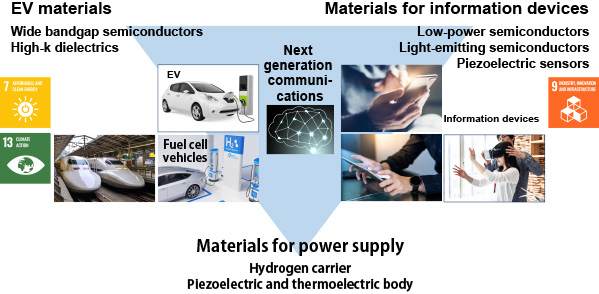
Societal needs
The ultimate goal of this institute is to explore the science of materials that have been discovered, develop new materials, and implement them in the world. We also aim to train researchers who can develop materials and take advantage of computational science and data utilization.
—What are the demands for future electronics material development?
Kamiya In conventional materials research at universities, a necessary requirement for writing a good paper was to provide world-record data with only one function. However, developing materials that can be put into practical use requires addressing conflicting needs (e.g., if you improve performance, stability will deteriorate; if you lower the operating temperature, performance will suffer). The aim of this institute is to develop completely new materials that can simultaneously meet multiple conflicting needs such as high performance and high stability, high speed and low temperature operation. We will actively utilize the complex structure of practical materials and develop new materials by utilizing computational science and data science in order to create materials with multiple features.
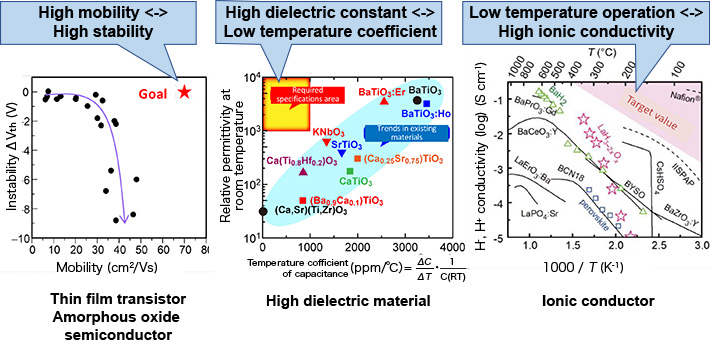
Examples of conflicting performance requirements
An example is an amorphous oxide semiconductor used as semiconductor material in thin film transistors for flat-panel displays. Currently, it is installed in various flat-screen displays such as organic light-emitting diode (OLED) TVs and high-resolution LCDs.
Amorphous oxide semiconductors are presently being used in these displays by taking advantage of their satisfactorily high electron mobility (~10 cm2/(Vs)) and low power consumption. However, that mobility is not satisfactory for very high-resolution OLEDs and peripheral circuits; therefore, they are used in combination with polycrystalline silicon semiconductors to create power-saving and high-performance wearable devices, such as in the Apple Watch. If the functionality of a silicon semiconductor can be achieved by a single amorphous oxide semiconductor, a silicon semiconductor would be unnecessary. As a result, for example, wearable devices could be made even smaller, lighter, and more sophisticated.
—How will you achieve multiple conflicting functional improvements?
Kamiya For example, the main target substance in our research has been high-quality single crystal with few defects, but there are some materials that realize functions by combining multiple/complex structures.
We know about core-shells that are already used as a dielectric. A core-shell structure, as the name implies, has a complex structure consisting of a central core and a shell that surrounds it, which provides multiple conflicting features.

Examples of electronics materials that realize conflicting properties
The key with such a complex structure is how to control it. For simple crystal structures, first-principles calculations(*) could be used to predict performance, but the design of complex and meso-scale structures is not easy with conventional computational science.
Therefore, there is a need for an approach called materials digital transformation (materials DX), which uses data science to develop viable materials at a high speed and with high efficiency. This will allow us to develop new materials for future electronics by combining various materials, not limited to complex structures.
* First-principles calculations
Calculations based on the fundamental principles of quantum mechanics. Using this method, not only the states of electrons that govern the properties of materials, but even the total energy of the structure can be calculated. It also becomes possible to predict the stable structures, chemical reactions, and physical properties.
—What is materials DX? How is it different from traditional materials informatics?
Kamiya Materials informatics (MI) has allowed for the discovery of new materials by making full use of computers. It started about 10 years ago and has led to the development of many materials. MI is basically used to find adjacent materials that are logical extensions of existing materials, using quantum computation and data analysis.
However, in order to discover a completely unknown material that is discontinuous in structure and properties from existing materials, it is necessary to further evolve MI, introduce the discovery of discontinuous structures and materials, accumulate and analyze nontypical data, and make full use of data science and machine learning (AI).
In particular, systematizing the "intuition" of researchers, such as their material design philosophy and strategy, and incorporating it into a human-in-the loop systematization so that they can be incorporated into data analysis will lead to the discovery of materials far removed from conventional material groups, analogous to a new world of materials. Once a candidate is found, MI can be used to discover adjacent materials. At this institute, we aim to build this kind of materials DX system, too.
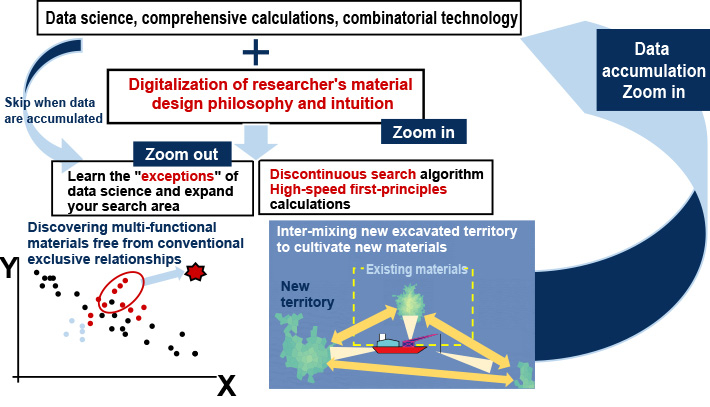
Concept of building an Material DX system to discover unknown materials
—What are your future development goals?
Kamiya Currently, we are aiming to develop a group of materials with conflicting performance requirements for semiconductors, dielectrics, ionic conductors, catalysts, etc.
Applications |
Materials |
Conflicting performance requirements |
Goals |
|---|---|---|---|
IoT, edge computing |
Amorphous / polycrystalline semiconductor |
High mobility <-> High stability <-> Low temperature formation |
Mobility > 70 cm2/(Vs) |
Power electronics |
Ultra wide bandgap semiconductor (Post Ga2O3) |
Wide bandgap <-> n/p carrier doping |
Eg > 5 eV, p/n control |
Dielectrics |
High permittivity <-> High temperature stability |
-55 – 250°C Relative permittivity > 1000 Temperature coefficient < 1000 ppm/°C |
|
Crystal semiconductor |
Low voltage <-> Low loss <-> Carrier injection <-> Work function control |
Work function |
|
IoT, edge computing |
Amorphous / polycrystalline semiconductor |
||
High frequency filter |
Dielectrics |
Low loss = High voltage constant <-> High elastic modulus |
Piezoelectric constant d33 > 30 pm/V Elastic modulus > 400 GPa |
Multi-phase functional materials to be developed
Semiconductors, ionic conductors, dielectrics, and catalysts are originally different research fields, which have had their own separate research and development for many years.
However, as shown in the figure "Joint development of materials from different related fields", semiconductors control the mobility of electrons, while ionic conductors control the mobility of ions. What both semiconductors and ionic conductors have in common is that they control the ease of movement of electrons and ions. Furthermore, in the intermediate space, we can find high-k dielectrics with a high permittivity where electrons are unable to move, but ions still move within the appropriated bound region. In other words, the four fields are actually closely related, and Material DX is made possible by sharing and combining information from these different fields across boundaries.
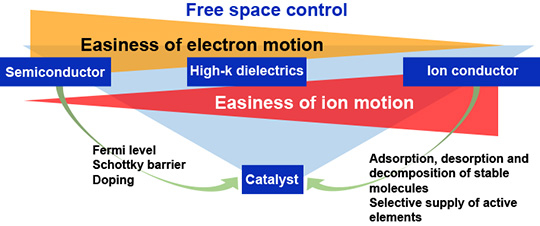
Joint development of materials from different related fields
By exchanging and sharing information among researchers in these four research fields, we have managed to develop innovative new materials at the Tokodai Institute for Element Strategy, led by Honorary Professor Hideo Hosono, which existed from 2021 to 2022 academic year.
In this way, we hope to bring about further innovation through robust interdisciplinary collaboration and exchanging and sharing both information and various experimental data. Crossing the boundaries between fields is a major role of the materials DX system.
—How do you train new researchers?
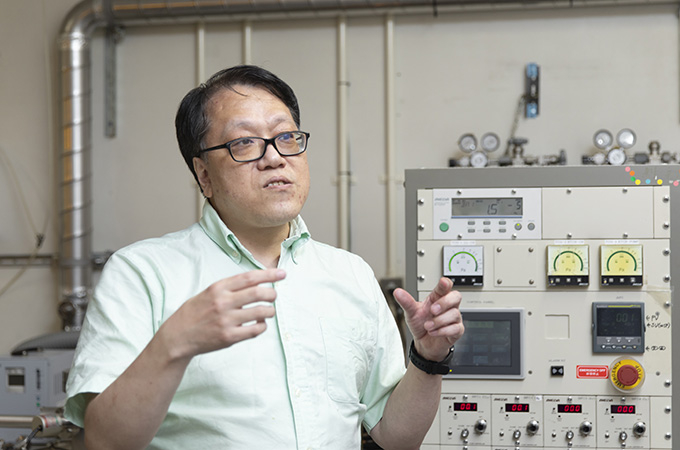
Kamiya The researcher's purpose is to find that which was unmapped, and to figure out that which was unknown. Improving existing technologies is part of research, but it is the role of the university to go further and pioneer new fields. And I think it is the responsibility of the university to nurture talent with such spirit and ability.
Indeed, it is our responsibility to discover entirely new materials like we've discussed here. We will adopt methods such as materials DX, but in the end, finding new materials from vast amounts of data requires such intuition of researchers with unique ideas.
In addition, talent that can take advantage of the materials field and computational and data science is increasingly important. Tokyo Tech already established the Academy for Convergence of Materials and Informatics in 2019 and is working to train this kind of talent.
—Please tell us about the organizational structure and future policy.
Kamiya Four organizations, Tokyo Tech, the National Institute for Materials Science (NIMS), the Japan Fine Ceramics Center (JFCC), and the High Energy Accelerator Research Organization (KEK), are participating in the MDX Institute.
The reason for this organizational structure is that Tokyo Tech has pulled off many achievements in material research and development. In addition, NIMS is the only national research institute specializing in science and engineering of inorganic materials. The Japan Fine Ceramics Center has advanced technology in computer simulations using quantum mechanics called "first principles calculations." KEK is a research institute in charge of doing highly accurate measurements and analysis of substances and materials. By the collaboration of these four institutions, we are trying to build a robust materials DX system that combines computational science and data science.
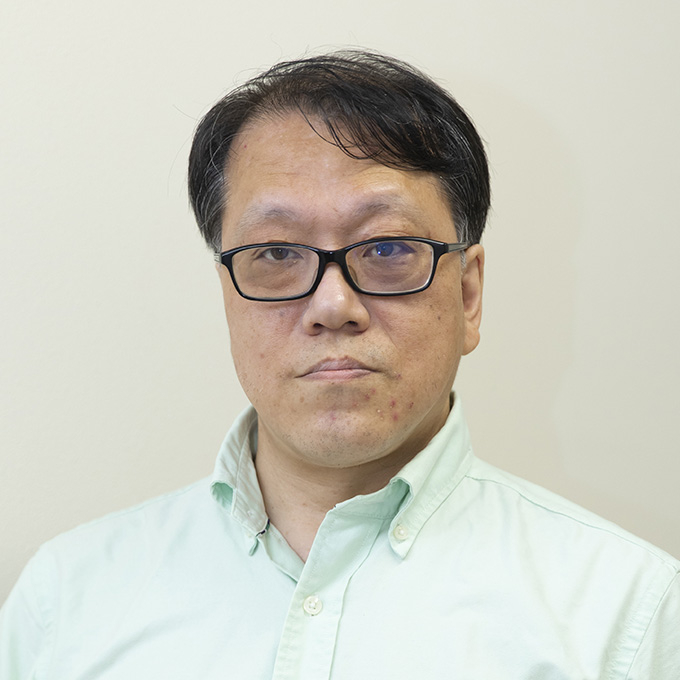
Toshio Kamiya
Professor, Institute of Innovative Research
MDX Research Center for Element Strategy
One of the keys to the development of future electronics materials is advanced research talent. Professor Takeo Yamaguchi, the director of the Tokyo Tech Academy for Convergence of Materials and Informatics, is responsible for training next generations of researchers be well-versed in both materials science and information technology. We talked about approaches to talent development, the features of curriculums, and collaboration with the MDX Institute.
—Please tell us the aim of establishing the Tokyo Tech Academy for Convergence of Materials and Informatics.
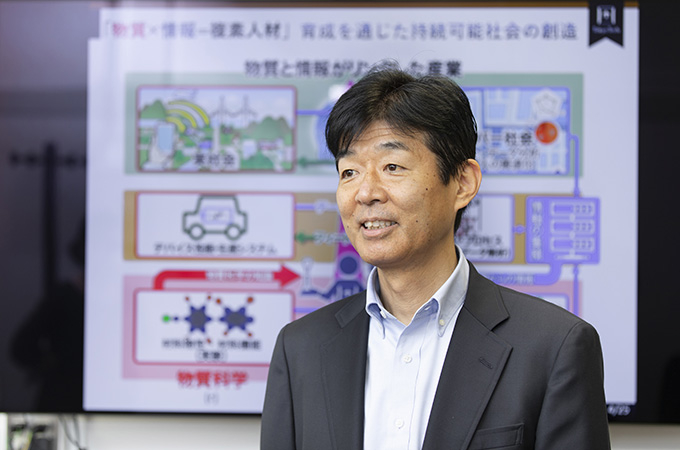
Director Takeo Yamaguchi
Yamaguchi The idea is to train doctoral students who will be well-versed in both manufacturing and information technology. We call this kind of talent "multitalented individuals." Tokyo Tech has strengths in "manufacturing" research based on substances and materials. However, the R&D approach to new materials is about to change dramatically, and new ideas are needed that are not just a logical extension of the past.
In order to make use of new materials in the real world, it is essential to have talent who can comprehensively provide everything from product research and development to real-world implementation and new services for a better world. Talent not only shortens the period from product development to real-world implementation, but also creates new services using technical innovation. In other words, the key is "manufacturing" from a higher perspective that takes advantage of data science and artificial intelligence (AI).
Therefore, we decided to integrate the two fields of materials science and information technology (which are strengths of Tokyo Tech) and promote the training of outstanding doctoral students in both fields.
![Creation of a sustainable society through the development of [Material×Information] multitalented individuals](/english/public-relations/img/kamiya-yamaguchi-10.jpg)
Creation of a sustainable society through the development of [Material×Information] multitalented individuals
—Is it not enough to teach data science at an existing graduate school? What is the need for doctoral students?
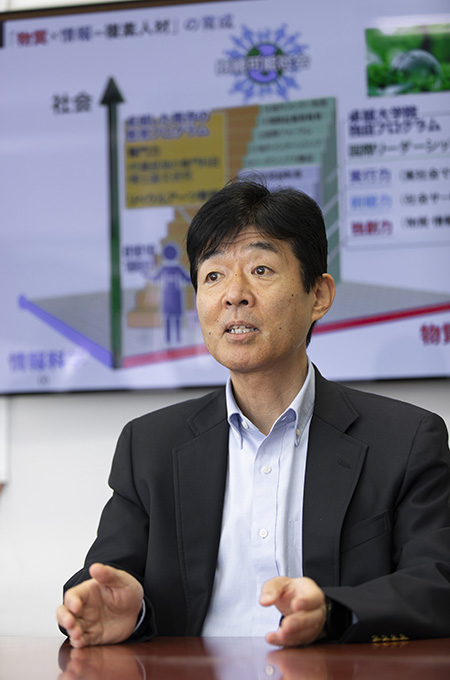
Yamaguchi We need people who have a deep understanding of both data science and materials science, a rare type throughout the world. In order to gain a deep understanding of these two academic disciplines, it takes the time and experience of completing a doctoral program, so doctoral students are the target.
But Japanese universities have the problem that fewer students go on to doctoral programs than in Europe and the United States. The reason is that in Japan there's a misunderstanding that getting a PhD doesn't result in much benefit in the real world. However, in Europe and the United States, you are not recognized as a full-fledged researcher unless you have a PhD. This will lead to a decline in the international competitiveness of Japanese companies that are becoming more globalized.
By offering co-creation education together with industry, the Academy provides financial support to doctoral students and is training excellent doctoral students who will become future leaders of society with the help of companies with abundant business experience. In addition, we are making significant changes to the compensation of doctoral students/graduates in the industrial world.
—Please tell us about the curriculum.
Yamaguchi First, students learn about computer simulations and MI using the Tokyo Tech supercomputer TSUBAME in exercise format.
After that is laboratory rotation, where materials students join an information laboratory and information students join a materials laboratory for 2 to 3 weeks to learn research and experiment skills. In addition to Tokyo Tech, students on laboratory rotation go to national research institutes such as NIMS.
![Curriculum to develop [Material×Information] multitalented individuals](/english/public-relations/img/kamiya-yamaguchi-11.jpg)
Curriculum to develop [Material×Information] multitalented individuals
Furthermore, when you enter the doctoral program, you will attend a Practice School. Three faculty members and about 10 students form a team and stay at a partner company for 6 weeks. By taking advantage of substance and materials knowledge and information science, students not only solve important cutting-edge problems at companies, but also propose the following policies and provide consulting.
It is run by two companies, one from August to September and one from October to November. Students access a lot of data at the company, acquire a higher perspective of important problems in the real world in a short period of time, and solve them with various ideas. A wide range of ideas can be created through contact with a lot of data, knowledge, and information, discussions with companies, and solving problems as a team of students from different fields. Through this experience, students themselves will be able to think about their research objectively and from a higher perspective and come up with new ideas. In addition, students will acquire practical skills to master simulations and MI. Students who have experienced a Practice School will return to the laboratory and introduce simulations and MI into their research, raising the level of the laboratory.
Student voices participating in the Practice Schools and laboratory rotations
Keiki Inoue, Practice School participant.
3rd-year doctoral student,
Chemical Science and Engineering.
Masami Sako, Lab Rotation Participant.
3rd-year doctoral student,
Computer Science.
—How are corporate evaluations of the Academy?
Yamaguchi At the time of its founding, the number of member companies was 15, but now it has reached 30, which seems like high praise. In fact, all the partner companies strongly feel the need for "multitalented individuals." There is one mentor from a company for every student, and everyone is very enthusiastic about talent development.
—Please tell us about the collaboration between the MDX Institute and the Tokyo Tech Academy for Convergence of Materials and Informatics.
Yamaguchi Advanced research is essential for advanced education, and it is a great pleasure for us to have a new research institute where this experience is possible. Students of the academy may get to enjoy laboratory rotation in a laboratory of the MDX Institute.
We hope that the doctoral students from the academy will have a synergistic effect by playing an active role at the institute. Our goal is to make Tokyo Tech one of the world's leading sites in the fields of materials and information in terms of both research and talent development.
—Finally, do you have a message for young people who will be in charge of our future world?
Yamaguchi In order to solve social problems, it is becoming increasingly important not only to delve deeper into your own specialized field, but also to expand your network in collaboration with different fields. In addition, while combining your field with a different field, it is important to be prepared to take the lead in that other field, identify its essence, and courageously offer new ideas. Only then can you become a leader who can transform the world. Tokyo Tech will strive to train such excellent doctoral students with high aspirations.

Takeo Yamaguchi
Professor, Laboratory for Chemistry and Life Science, Institute of Innovative Research
Director of the Tokyo Tech Academy for Convergence of Materials and Inoformatics
About the WISE Program (Doctoral Program for World-leading Innovative & Smart Education)
A program started in 2018 to promote the training of doctoral students under the initiative of the Ministry of Education, Culture, Sports, Science and Technology. With the strengths of individual universities at its core, this program features robust cooperation with domestic and overseas research institutes and private companies, as well as integrated master's and doctoral degrees, training excellent doctoral students and forming an excellent site for the continuous development of new collaborative research. The Tokyo Tech Academy for Convergence of Materials and Informatics aims to develop the knowledge professionals needed by the future society, based not only on the strengths of Tokyo Tech but also co-creation with companies, and receiving financial support from the private sector.
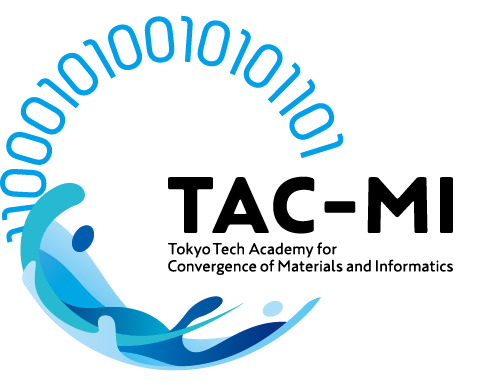 Students are participating from not only schools with research focused on material development and information science (School of Materials and Chemical Technology, School of Computing, etc.), but from all schools including the School of Science, the School of Engineering, the School of Life Science and Technology, and the School of Environment and Society.
Students are participating from not only schools with research focused on material development and information science (School of Materials and Chemical Technology, School of Computing, etc.), but from all schools including the School of Science, the School of Engineering, the School of Life Science and Technology, and the School of Environment and Society.
Other Tokyo Tech WISE academies
The Special Topics component of the Tokyo Tech Website shines a spotlight on recent developments in research and education, achievements of its community members, and special events and news from the Institute.
Past features can be viewed in the Special Topics Gallery.
Published: October 2022